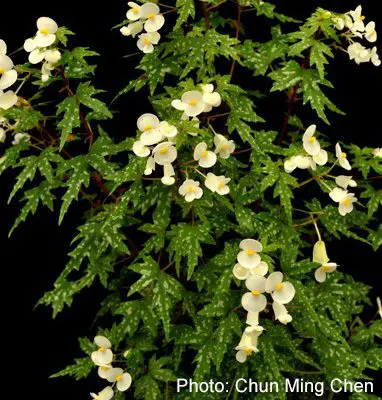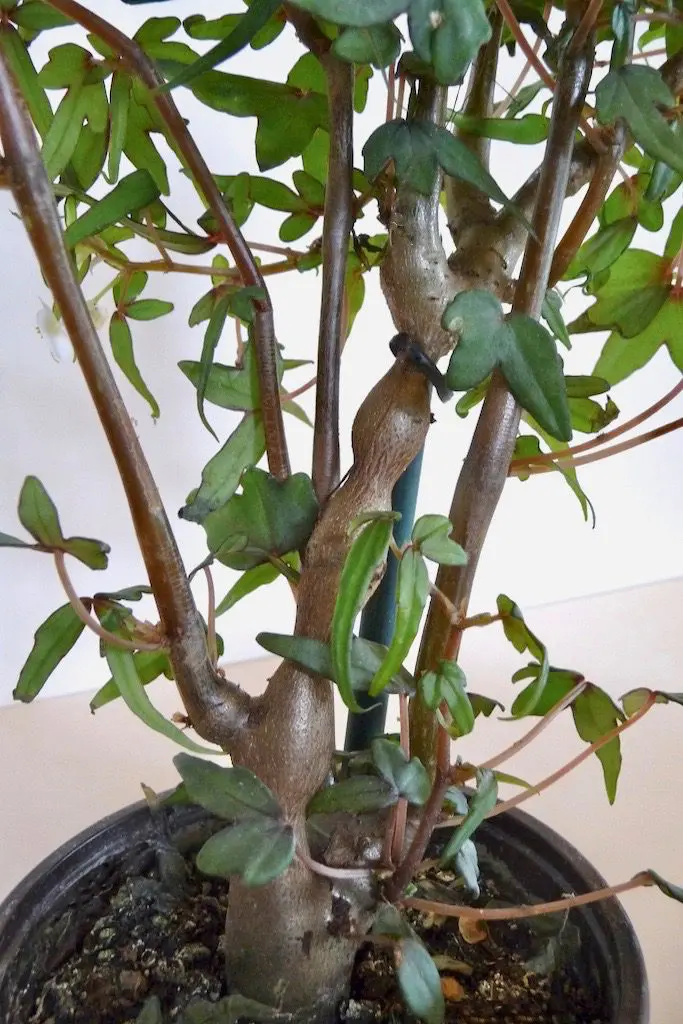This plant was discovered by J.F Drège in the Cape of Good Hope, South Africa in 1836, the same year it was described. While the plant is classed as semi-tuberous, it forms a caudex at its base, not a tuber. Because the plant has been in cultivation for so long, much has been written about it. It has also been extensively used in hybridization. B. dregei is an easy plant to grow but does need careful watching. Mealy bugs will appear on this plant in abundance before they even show up on nearby plants. It is also very prone to powdery mildew. It does not need a lot of water, nor does it require a large pot as the caudex stores moisture. B. dregei appreciates a lot of light, but not direct sun which easily burns its thin leaves.
There does not seem to be a particular time of year during which its white blooms appear. If plants are started from stem cuttings, the characteristic caudex will not be nearly as large as those on plants grown from seed.
B. dregei is often called the ‘maple-leaved’ begonia which has led to some confusion, because there are several caudex-forming begonias from South Africa that fit that ambiguous common name. Some of these plants have been published as separate species and others are listed as varieties of B. dregei. The topic of correct names has been addressed in The Begonian. Much of the confusion in naming is due to the fact that many of these plants are found in small, isolated populations in nature and that they hybridize easily with one another. Aside from B. dregei var. dregei, some of the more distinct plants are B. suffruticosa, B. partita, and B. dregei ‘Glasgow.’
Further information about this group of plants can be found in the March 1974 issue of The Begonian on pages 62-71 written by Carrie Karegeannes.
As mentioned earlier, there are many named hybrids using B. dregei. It is interesting that it crosses with plants from different horticultural groups. When crossed with rexes, small-leaved upright plants are usually produced. When crossed with B. socotrana, the begonia world’s only known bulbous variety, a floriferous but rarely seen group labeled Cheimantha is produced. They are ‘cousins’ to Reiger begonias. Crossing with canes produces small-leaved, many branched, cane-like progeny.
Some of the more distinctive hybrids are B. ‘Weltonensis’ (a B. dregei look-alike), B. ‘Airy Fairy,’ and B. ‘Richard Robinson.’ This last was named by Alfred D. Robinson, an early 20th Century San Diego grower. He grew hundreds of plants from seeds to prove that B. dregei was a species. One unique plant came up in all the seedlings and he selected it for release.
One last culture point for B. dregei hybrids is that all progenies are mealy bug and mildew prone.



